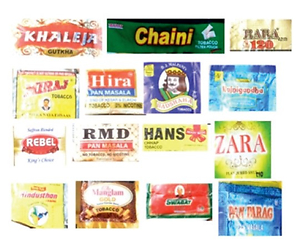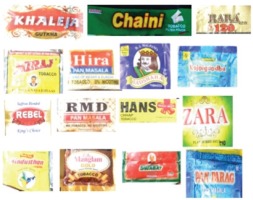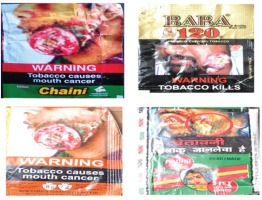INTRODUCTION
Tobacco consumption is a major contributing and risk factor and the 6th leading cause of death globally1. Smokeless tobacco is consumed in an unburnt form and has been widely used orally or through nasal inhalation2. Smokeless tobacco products have differences in their composition, preparation, and toxicity, but they all consisting of a nicotine alkaloid3. The chemical constituents or main ingredients present in the smokeless tobacco products are nicotine, tobacco-specific N-nitrosamines (TSNA), nitrosamine acids, polycyclic aromatic hydrocarbons (PAHs), aldehydes, and heavy metals4. Globally, the consumption of smokeless tobacco is largely concentrated in India and Bangladesh. These two countries have 80% of the 300 million smokelesstobacco users worldwide5,6. The tobacco industry invests half a billion dollars annually to promote the manufacture of SLT products, twice as much as earlier7,8. Recently, the Food and Drug Administration (FDA) proposed a rule to reduce the amount of tobacco-specific N-nitrosamines in SLT products in the United States due to their carcinogenic activity9.
Smokeless tobacco users who dip or chew 8–10 times a day might ingest a similar amount of nicotine as cigarette smokers who smoke 30–40 cigarettes per day10,11. The consumption of smokeless tobacco is higher due to the greater social acceptance, curiosity, and culture, which are influencing factors for SLT initiation and prevalence. About 35–40% of tobacco consumption in India is in smokeless tobacco forms, most of which is Nicotiana rustica, while most smoking tobacco is Nicotiana tabacum12. There are several types of chewing habits like the use of betel quid, khaini, mawa, panmasala plain without tobacco, and gutkha13. Promotion of SLT use has increased as non-users start to use SLT, which serves as an alternative to smoking and leads to dual-users of tobacco14,15 with the number of consumers increasing annually.
To combat the above epidemic, the Indian government has introduced warning labels for cigarettes or other tobacco products16. Tobacco warning labels are a useful tobacco control tool, however research has shown that attention to warnings and exposure to current health warning labels is lowest among individuals with lower education and income17,18. Health warnings on product packaging are a costeffective, population-wide strategy to inform populations about the health risks associated with tobacco consumption19.
The aim of the present study is to examine the reported composition, characteristics and manufacturers of smokeless tobacco products in India.
METHODS
This was a cross-sectional pack-collection study. Available information on details and product profiles of various SLT products and pictorial warnings labels were collected from retail shops in Ananthapur, India. The different SLT products include panmasala, gutkha, khaini and tobacco brands, purchased from nearby paan shops. The baba chewing tobacco is available in various types and this information was collected from owners of paan shops.
RESULTS
Tables 1–3 depict the current types of smokeless tobacco products available for sale in Ananthapur, India, including their reported ingredients, price, and manufacturer.
Table 1
Tobacco brands available in Andhra Pradesh, India
Table 2
Gutkha brands available in Andhra Pradesh, India
Table 3
Panmasala product brands available in Andhra Pradesh, India
Figures 1 and 2 present the images of different smokeless tobacco products available (including khaleja and rebel brands of gutkha, chaini brand of khaini, rajnigandha, hira, RMD, and panparag panmasala brands, baba 120 chewing tobacco, miraj, badshaha, hans chhap, zara snus, hindhusthan, manglam gold tobacco, swagat tobacco brands) in the Indian tobacco market.
Most of the sampled smokeless tobacco products have the common pictorial health warning labels: ‘Chewing of panmasala is injurious to health; Tobacco causes mouth cancer; Tobacco kills; Chewing of tobacco is injurious to health; and Tobacco is injurious to health’ (Table 4).
Table 4
Pictorial health warning labels on smokeless tobacco products
DISCUSSION
Our observational study identified numerous sub-brands, ingredients, and warning labels across multiple types of smokeless tobacco products in India, providing a glimpse of a smokeless tobacco market.
The reported smokeless tobacco constituents might contribute to the development of adverse health effects among consumers. Gutkha, panmasala, khaini and tobacco products are the multiple forms of smokeless tobacco that are locally made and consumed throughout India. The common factors of sex, age, ethnic origin, and socioeconomic status showed variation in the pattern of consumption of SLT20. The smokeless tobacco industry is actively engaged in the production of larger number of SLT products, which are addictive nicotine containing products21. Nicotine itself and tobacco-specific N-nitrosamines are actively involved in the formation of reactive oxygen species (ROS) in the mouth22,23.
Increasing product labelling as a means of increasing public awareness holds significant policy implications, including sustained investment in evidence-based mass media campaigns as part of a comprehensive tobacco control strategy24. This should be taken further in light of the evidence that the enactment of smoke-free legislation has been associated with an increased consumption of smokeless tobacco among adolescent males25.
The taxes on SLT products remain low compared to smoking cigarette products in Bangladesh and the amendment made in Tobacco Control Law in 2013 requires graphic health warnings to cover 50% of SLT packaging, a ban on advertisement of SLT products, and restriction of sales to minors26. The increased use of smokeless tobacco products is directly proportional to cessation of smoking. The increasing prices of SLT products, which have doubled, may indirectly discourage people from using SLT products27. A similar increase in tobacco consumption is occurring globally, with a concomitant increase in tobacco-related deaths and diseases28.
CONCLUSIONS
Smokeless tobacco represents an addictive product in need of specific regulation. The Indian government has enforced tobacco control laws like COTPA ACT 2003 and introduced pictorial health warning labels on packets of SLT products, which are important to protecting public health. As identified by their list of reported ingredients, use of smokeless tobacco products pose a significant health risk, hence the continuation and further strengthening of health warning labels on smokeless tobacco products should be encouraged.




